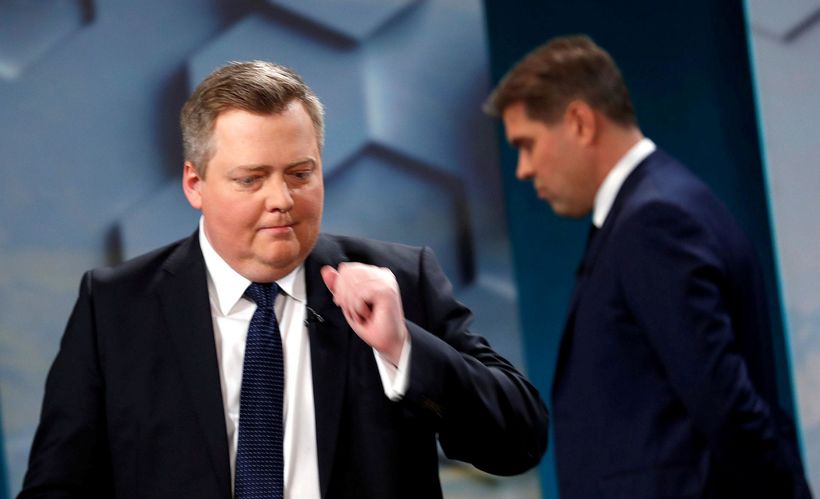General Elections in Iceland bring a complicated political landscape

Icelanders wake up to a different political landscape after Saturday’s general elections. The three parties that made up the center-right coalition government lost 12 of their 32 seats in Iceland’s 63 member parliament. The opposition parties, taken together, did however only win one of the seats lost by the outgoing government parties. Instead, two new entrants on the political scene snapped up the other 11 seats.
[For more coverage, see Iceland Monitor’s 2017 election page]
Complex coalition talks ahead
The new parliament will be made up of eight political parties, more parties than ever before. In light of that the last year’s coalition talks took almost three months to complete, forming a new coalition government after this elections is expected to be complicated. A three-party coalition government would only be possible with the inclusion of both the Independence Party and the Left-Green Movement, any other coalition would require four or more members.
Here is the breakdown of the winners and losers:
The Independence Party: 25.5 percent – 16 seats
While the right-of-center Independence Party lead by Prime Minister Bjarni Benediktsson retains its position as Iceland’s largest political party as it has most if its history, it lost five of its 21 seats in parliament. Despite the outcome, Benediktsson had a reason the celebrate as many of the opinion polls published last week showed the Indpendence Party receiving far less support.
The Left-Green Movement: 16.9 percent – 11 seats
The Left-Green Movement, lead by former Minister of Education Katrín Jakobsdóttir gained one seat in the election. This is less than many opinion polls predicted; the Left-Greens were polling near 30 percent earlier this month. Jakobsdóttir is seen as a candidate for the Premiership by many in a potential left-of-center coalition government. The party is Iceland’s second largest parliamentary party, a position it attained in last year’s elections.
The Social Democratic Alliance: 12.1 percent – 7 seats
The Social Democratic Alliance, lead by MP Logi Einarsson, came close to losing all its parliamentary seats in last year’s elections, when it received only 5.7 percent of the votes and three MPs. The Social Democrats have made somewhat of a comeback. This is however far from its best results, but in the elections held 1999 to 2009 it received between 26-31 percent of the votes.
The Progressive Party: 10.7 percent – 8 seats
The Progressive Party, lead by former Prime Minister Sigurður Ingi Jóhannson, received less support than in previous elections, but holds on to its eight parliamentary seats. When the snap elections were called last September, former party leader and Prime Minster Sigmundur Davíð Gunnlaugsson left the party and founded the Center Party. Many senior figures and members left the Progressives and joined the new Center Party. Despite the split, the Progressive Party has managed to retain most of its support from last year’s elections.
The Center Party: 10.9 percent – 7 seats
A newcomer on the scene, the Center Party was founded and is led by former Prime Minister and Progressive Party leader, Sigmundur Davíð Gunnlaugsson. The Center Party is making a strong entry into the political scene, making it the big winner of the yesterday’s elections. This is especially a sweet personal win for Gunnlaugsson who was forced to step down as PM amidst the Panama Papers scandal, and consequently ousted as party leader.
The Pirate Party: 9.2 percent – 6 seats
The Pirate Party upended Icelandic politics last year when it won 14.5 percent of the votes and 10 seats in parliament. It had strong support in opinion polls in early 2016 and was at times measured as the largest political party in Iceland, a lead that it lost in the run-up to the 2016 fall elections (see here and here). In yesterday’s elections, the Pirate Party lost almost a third of its electoral support and saw its parliamentary party shrink.
The People’s Party: 6.9 percent – 4 seats
The People’s Party is another newcomer in the Icelandic parliament, led by Inga Sæland. The People’s Party received 3.5 percent and failed to earn seats in parliamentary in last year’s elections, but the cutoff is 5 percent. The party was polling high early in this year’s campaign, but saw its support drop below the cutoff in the days leading up to election day. They seem to have had a strong finish at the end however, and Sæland and her team have a reason to rejoice as one the election’s big winners.
Restoration: 6.7 percent – 4 seats
A newcomer in last year’s election, Restoration positions itself as center or right-of-center on the political sphere. Many of its members were members of the Independence Party, including newly elected party leader Þorgerður Katrín Gunnarsdóttir and current Minister of Fisheries and Agriculture. Gunnarsdóttir served as the deputy leader of the Independence Party 2005-2010, and as an Education Minister on behalf of the Independents 2003-2009. Restoration entered parliament last year with seven MPs after winning 10.5 percent of vote. After long-winded coalition talks that took almost three months, Restoration joined a coalition government with the Independence Party and Bright Future.
Bright Future: 1.2 percent – 0 seats
The left-of-center Bright Future, lead by Minister of Health Óttarr Proppé, entered parliament in 2013 with 8.2 percent of the votes and six MPs. In the 2016 elections it received 7.2 percent and four MPs. Last September and less than nine months after forming a coalition government led by the Independence Party, Bright Future withdrew from the coalition citing a “serious breach of trust” following revelations that the Prime Minister’s father had provided a letter of recommendation for a convicted child abuser seeking to “restore his honor.” In yesterday’s elections, Bright Future saw its support almost disappear, making it the biggest loser of the 2017 elections.